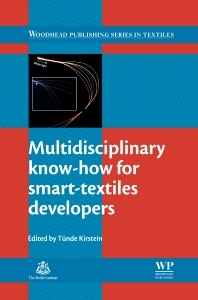Multidisciplinary Know-How for Smart-Textiles Developers Woodhead Publishing Series in Textiles Series
Coordonnateur : Kirstein Tünde

Contributor contact details
Woodhead Publishing Series in Textiles
Chapter 1: The future of smart-textiles development: new enabling technologies, commercialization and market trends
Abstract:
1.1 Introduction
1.2 The technological trade-off between smartness and integration
1.3 New enabling technologies for smart textiles
1.4 New approaches in commercialization of smart textiles
1.5 Future trends
1.6 Conclusion
Part I: Materials
Chapter 2: Types and processing of electro-conductive and semiconducting materials for smart textiles
Abstract:
2.1 Introduction
2.2 Electro-conductive and semiconductive materials
2.3 Electro-conductive materials and their properties
2.4 Metals
2.5 Carbon: carbon black (CB), graphite and carbon nanotubes (CNT)
2.6 Intrinsically conductive polymers (ICP)
2.7 Semiconductive materials and their properties
2.8 Processing electro-conductive and semiconductive materials into textile structures
2.9 Future trends
2.10 Sources of further information and advice
Chapter 3: Optical fibers for smart photonic textiles
Abstract:
3.1 Introduction to photonic textiles
3.2 Total internal reflection (TIR) fiber-based photonic textiles
3.3 Photonic bandgap (PBG) fiber-based photonic textiles
3.4 Photonic textile manufacturing
3.5 Reflective properties of photonic bandgap textiles under ambient illumination
3.6 Animated photonic bandgap textiles using mixing of ambient and emitted light
3.7 Potential applications of photonic bandgap textiles
3.8 Conclusion
3.9 Acknowledgments
Chapter 4: Conductive nanofibres and nanocoatings for smart textiles
Abstract:
4.1 Introduction
4.2 Conductive nanofibres
4.3 Conductive nanocoating
4.4 Application of nanotechnology in smart textiles
4.5 Future trends
4.6 Sources of further information and advice
Chapter 5: Polymer-based resistive sensors for smart textiles
Abstract:
5.1 Introduction
5.2 Mechanical resistive sensors
5.3 Chemical resistive sensors
5.4 Temperature resistive sensors
5.5 Conclusion and future trends
Chapter 6: Soft capacitance fibers for touch-sensitive smart textiles
Abstract:
6.1 Introduction: overview of capacitive sensing
6.2 Soft capacitor fibers for electronic textiles
6.3 Electrical characterization of the isolated capacitor fiber
6.4 Capacitor fiber as a one-dimensional distributed touch sensor
6.5 Fully woven two-dimensional touch pad sensor using one-dimensional array of capacitance fibers
6.6 Conclusion
Part II: Technologies
Chapter 7: Textile fabrication technologies for embedding electronic functions into fibres, yarns and fabrics
Abstract:
7.1 Introduction
7.2 Fibre and yarn production processes: natural fibres
7.3 Fibre and yarn production processes: continuous (man-made) fibres
7.4 Functionalisation of fibres and yarns
7.5 Fabric production: weaving
7.6 Fabric production: knitting
7.7 Fabric production: braiding
7.8 Embroidery
7.9 Challenges in smart-textile production
Chapter 8: Fabrication technologies for the integration of thin-film electronics into smart textiles
Abstract:
8.1 Introduction
8.2 Merging flexible electronics and smart textiles
8.3 Demonstrators
8.4 Mechanical reliability of contacts
8.5 Conclusion and future trends
8.6 Sources of further information and advice
Chapter 9: Organic and large-area electronic (OLAE) technologies for smart textiles
Abstract:
9.1 Introduction
9.2 Flexible technologies for textile integration
9.3 Circuit design
9.4 Textile integration
9.5 Packaging integration and service life issues
9.7 Appendix: abbreviations and acronyms
Chapter 10: Joining technologies for smart textiles
Abstract:
10.1 Introduction
10.2 Components of electronic systems in textiles
10.3 Conductive threads as electrical traces
10.4 Introduction to joining technologies for electronics
10.5 Overview of existing jointing technologies in the electronics and in the textile world
10.6 Summary to the joining technology overview
10.7 Protection of electrical connections
10.8 Challenges for electronic systems on textiles
10.9 Challenges for automated processes in electronic systems on textiles
10.10 Future trends
Chapter 11: Kinetic, thermoelectric and solar energy harvesting technologies for smart textiles
Abstract:
11.1 Introduction
11.2 Energy sources and storage: key issues
11.3 Fabrication processes
11.4 Kinetic energy harvesting for smart textiles
11.5 Thermoelectric energy harvesting for smart textiles
11.6 Solar energy harvesting for smart textiles
11.7 Conclusion
Chapter 12: Signal processing technologies for activity-aware smart textiles
Abstract:
12.1 Introduction: from on-body sensing to smart assistants
12.2 Activity-aware applications
12.3 Sensing principles for activity recognition
12.4 Principles of activity recognition
12.5 Signal processing and pattern analysis
12.6 Experimental aspects
12.7 Future trends
12.8 Sources of further information and advice
12.9 Acknowledgments
Part III: Product development and applications
Chapter 13: Technology management and innovation strategies in the development of smart textiles
Abstract:
13.1 Introduction
13.2 Fundamentals of innovation, technology and intellectual property management
13.3 Business models for smart textiles
13.4 Opportunities and challenges in the e-textiles business
13.5 Conclusion
13.6 Sources of further information and advice
Chapter 14: Improving the sustainability of smart textiles
Abstract:
14.1 Introduction
14.2 Sustainable production of smart textiles
14.3 Recycling, a necessity
14.4 Product durability
14.5 Sustainable design approach for a smart-textile product, an example
14.6 General guidelines for the design of sustainable smart-textile products
Chapter 15: Medical applications of smart textiles
Abstract:
15.1 Introduction
15.2 Monitoring of body parameters
15.3 Challenges in medical smart textiles
15.4 Trends and applications of medical smart textiles
15.5 Conclusions
Chapter 16: Automotive applications of smart textiles
Abstract:
16.1 Introduction
16.2 The use of textiles in vehicles
16.3 Smart-textile applications and their potential for use in cars
16.4 Prototypes of smart-textiles applications in vehicles
16.5 Key safety and quality requirements
16.6 The impact of electric vehicles on smart-textiles applications
16.7 Future trends
Chapter 17: Architectural applications of smart textiles
Abstract:
17.1 Introduction: key themes in modern architecture
17.2 Smart materials
17.3 Applications
17.4 Future trends
Index
- Reviews materials used in the production of smart textiles
- Examines the technologies used in smart textiles, such as optical fibres and polymer based resistive sensors
- Investigates strategies for technology management, innovation and improved development
Date de parution : 04-2013
Ouvrage de 524 p.
15.5x23.2 cm



